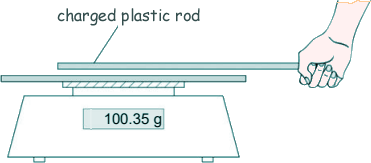GCSE Questions: Static Electricity Q11. Mina rubbed a plastic rod with a cloth. box The rod became negatively charged and the cloth became positively charged. (a) Explain why the cloth became positively charged. The rod and cloth are both neutral insulators to begin with - that means that each one has equal positive and negative charge. When the rod is rubbed with the cloth electrons transfer from the cloth to the rod - charging by friction. Electrons are negatively charged
[3 marks] This diagram shows the negatively charged rod on a balance.
This diagram shows another charged rod being held stationary above the rod on the balance.
The rods do not touch each other.
(b) Explain why the reading on the balance increases. The first reading is simply the mass of the rod exerting a gravitational downwards force (its weight). When the held rod is brought near to the rod resting on the balance they repel each other, as they are both of the same charge (negative) The force of repulsion makes the rod on the balance move away from the held one and exerts an additional downwards force on the balance - increasing the mass reading. [3 marks] (c) The balance had a zero error. The zero error is not important in this experiment. Give the reason why. The absolute value does not matter - only the change in reading/mass is being observed. [1 mark] (d) A negatively charged rod is held near an earthed conductor. Explain why a spark jumps between the negatively charged rod and the earthed conductor. The large potential difference between the two objects [3 marks] [Total 10 marks]
|
Follow me...
|







